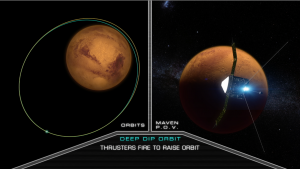
MAVEN began its fifth “deep dip” campaign of the mission this week. Three maneuvers were successfully carried out to lower the periapsis (or lowest) altitude of the spacecraft by approximately 29 kilometers (18 miles), placing MAVEN into the targeted density corridor, where the average density of Mars’ atmosphere is 3.0 kg/km³. The fifth deep dip for MAVEN is uniquely located over the solar terminator (the boundary between dayside and nightside), close to the ecliptic plane, and at a Martian latitude of 35ºN. The three maneuvers—carried out on June 7 & 8—required a total ∆V of 4.6 m/s and resulted in a periapsis altitude of ~119 km (74 mi).
The purpose of the MAVEN deep dip campaigns is to sample a full range of altitudes within the upper atmosphere of Mars, providing complete coverage of this region. At 119 km, MAVEN reaches the Martian homopause, which is the lower, well-mixed region of Mars’ upper atmosphere, where the density is about thirty times greater than at periapsis during a typical science orbit.
Serendipitously, a solar event hit Mars on June 9, just as the MAVEN spacecraft began its latest deep dip campaign. This activity won’t affect the safety of MAVEN or the mechanics of carrying out the deep dip, but should yield some very interesting science results!
Many of the instruments on MAVEN are specifically designed to study solar energetic particles, how they impact Mars’ upper atmosphere and ionosphere, and how they increase atmospheric escape rates.
Find out more about how MAVEN measures the solar wind and how solar energetic particles and extreme ultraviolet irradiance interact with Mars’ upper atmosphere: https://lasp.colorado.edu/maven/science/space-weather.
[addthis]

